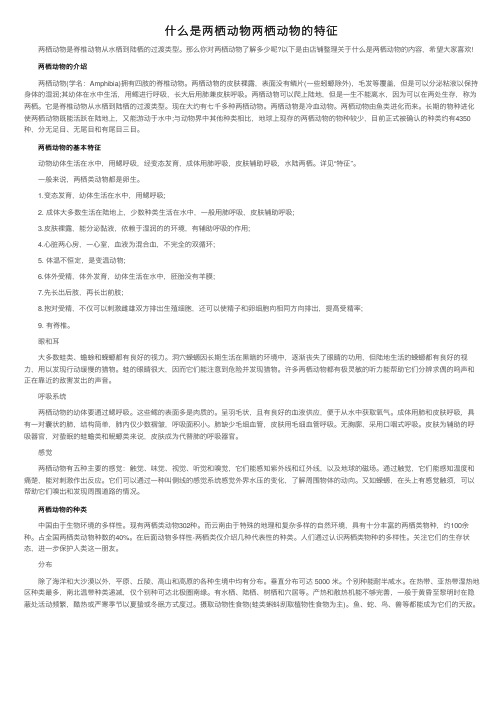内容非常全面-两栖动物百科全书
动物世界大百科读后感

动物世界大百科读后感《动物世界大百科》是一本内容丰富、图文并茂的百科全书,本书共收录了各种不同种类的动物信息,包括哺乳动物、鸟类、爬行动物、两栖动物等。
我非常喜欢这本书,因为它提供了关于动物世界的全面和深入的知识,让我对大自然的多样性和神奇之处有了更深的认识。
首先,该书的内容非常全面。
它以字母顺序排列动物名称,每个动物都有详细的介绍,包括外貌特征、生活习性、栖息地、饮食习惯等。
无论是大象、狮子还是蓝鲸,该书都能帮助我了解它们的特点和生存方式。
另外,该书还包括一些不常见的动物,如犀鸟、叶田鼠等,这些动物可能平时很少被提到,但它们同样值得我们关注。
通过这本书,我深深感受到了大自然的众多奇观和生命的多样性。
其次,该书的图文并茂给读者提供了更直观的了解。
书中每个动物的介绍都配有精美的照片和插图,这些图片用最真实的形态展现了动物的外貌和生活环境。
例如,当我看到照片中远处的雄鹿雄踞在群山之巅时,我仿佛能感受到它们的威严和力量;当我看到一只可爱的袋熊抱着它的宝宝时,我感受到了母爱的伟大和温暖。
这些图像让我更深入地了解了动物们的生活状态,也增添了阅读的乐趣。
此外,书中还有一些有趣的小知识和故事,让读者更容易接受和理解。
例如,在大象的介绍中,书中提到了大象在夏日中玩水散热的习惯,这个有趣的细节让我对大象有了更深的印象。
另外,在一些动物故事中,如企鹅父母为了给幼鸟找食而奋不顾身,或者是猴子之间的智慧竞赛,这些故事让我体会到动物们的智慧和独特的行为方式。
这些小知识和故事激发了我对动物世界的兴趣,也让我更加关注保护动物和生态环境的重要性。
通过阅读《动物世界大百科》,我不仅了解了动物们的种类和特征,也学到了如何与它们和谐共处。
我明白了人类与自然相互依存的重要性,同时也更加珍惜自然界的生命和生态环境。
这本百科全书对于广大的动物爱好者和学生来说都是一本难得的学习资料和读物。
无论是年幼的孩子还是成年人,都能在这本书中找到属于自己的知识乐园。
一本看遍动物世界的主要内容

一本看遍动物世界的主要内容《动物世界》这本书是一本关于动物的百科全书,内容丰富多样,包含了各种各样的动物信息。
以下是这本书的主要内容。
第一章:动物的分类本章介绍了动物的分类系统,从无脊椎动物到脊椎动物的分类和特征。
主要包括昆虫、蜘蛛、软体动物、节肢动物和鱼、羊膜动物、两栖动物、爬行动物、鸟类、哺乳动物等各大类的动物。
每个类别都详细介绍了不同物种的特点和习性。
第二章:动物的生态系统本章讲解了动物在不同环境下的生存方式和适应能力。
包括陆地、水域、空中等各种生态系统的动物。
例如,草原上的大象、非洲草原上的斑马、南极的企鹅以及海洋深处的鲸鱼等。
此外,还讲述了动物间的食物链和食物网关系。
第三章:动物的繁殖与生长本章详细介绍了动物的繁殖方式和生长过程。
包括性交、孕育、卵生和胎生等不同的生殖方式。
还介绍了动物幼崽的成长过程,包括母亲的照料和保护以及幼崽的成长和适应环境的能力。
第四章:动物的行为和智慧本章探讨了动物的行为和智慧。
介绍了动物的运动能力、寻找食物的技巧、谋求保护的行为等。
还介绍了一些动物团队合作、社交行为和学习能力的示例,例如狼的群居和猴子的智力表现。
第五章:动物的进化和保护本章讲述了动物的进化历程以及保护动物的重要性。
详细介绍了进化理论和适应环境的机制。
还讨论了外来物种入侵、栖息地破坏和气候变化等对动物的威胁,以及保护动物的方法和措施。
第六章:动物的美丽和奇特之处本章主要介绍了一些外貌美丽和身体奇特的动物。
例如鹦鹉的灵活多彩的羽毛、孔雀的华丽尾羽、变色龙的色彩变化、水母的发光等。
还介绍了一些具有特殊能力或特征的动物,例如螳螂的捕食技巧和豪猪的防御策略。
第七章:与动物的互动本章讲述了人类与动物之间的互动关系。
介绍了人类驯养动物的历史和驯养技术。
还讲述了与动物一起生活的好处和挑战,例如宠物的陪伴和农牧业的发展。
第八章:未来的动物世界本章展望了未来动物世界的可能变化。
讨论了科技进步可能带来的动物保护、人工种群繁育和基因编辑等方面的影响。
两栖动物的结构与生活习性

公众参与和教育普及
提高公众保护意识
通过媒体宣传、科普讲座等形式 ,提高公众对两栖动物保护的认 识和意识,形成全社会共同参与
的良好氛围。
开展志愿者活动
组织志愿者定期开展两栖动物调查 和监测工作,及时发现和解决存在 的问题,推动保护工作深入开展。
加强学校教育
将两栖动物保护知识纳入中小学教 育体系,培养青少年热爱自然、保 护生态环境的良好品德。
04
营养需求与食性
食物来源及捕食技巧
两栖动物的食物来源广泛,包括昆虫、小型 节肢动物、软体动物、鱼类、其他两栖动物 等。
捕食技巧因种类而异,一些两栖动物具有长 而粘的舌头,可以快速捕捉飞行或爬行中的 昆虫;另一些则具有锐利的牙齿和强壮的颚 部,可以咬住并吞下较大的猎物。
一些两栖动物还会利用毒液或毒腺来制服猎 物,使其更易于捕食。
两栖动物广泛分布于全球各地,从热带到温带、寒带都有它 们的踪迹。
栖息地类型
两栖动物主要栖息在水域附近,如池塘、沼泽、溪流等,也 有部分种类生活在森林、草原等陆地环境中。
02
身体结构特点
皮肤系统
薄而湿润
两栖动物的皮肤通常较薄,保持湿润状态, 有利于呼吸和水分吸收。
粘液腺
皮肤上有粘液腺,分泌粘液保持体表湿润并 减少水分蒸发。
04
能量代谢与储存策略
两栖动物的能量代谢相对较低,这有助于它 们在食物短缺时存活下来。
在寒冷季节或干旱时期,一些两栖动物会进 入休眠状态,降低能量消耗并依靠体内储存
的能量物质维持生命活动。
一些两栖动物会在体内储存脂肪或糖原等能 量物质,以备不时之需。
两栖动物的能量代谢和储存策略因种类和环 境条件而异,是它们适应自然环境的重要手 段之一。
两栖动物

巴西红耳龟,原产地并非巴西, 而是生存于北美密西西比河及格兰 德河流域。具有很高的食用、药用 和观赏价值,而且很适宜人工养殖。 现已被不少家庭当作宠物来养殖。 近几年"巴西龟"在中华大地遍 地"开花",占据了大面积属于中国 本土龟种的野外生存空间。因大量 掠夺同类生存资源被列为世界最危 险入侵物种之一。所以爱好放生的 人们切记不要购买巴西龟用来放生, 否则放生则会变成“杀生”。
• 眼镜王蛇,其平均体长为3.6–4米,体 重一般为6千克。寿命在20年左右。 • 虽称为"眼镜王蛇",但此物种与真正 的眼镜蛇不同,它并不是眼镜蛇属的 一员,而是属于独立的眼镜王蛇属。 • 相比其他眼镜蛇性情更凶猛,反应也 极其敏捷,头颈转动灵活,排毒量大, 是世界上最危险的蛇类之一。 • 在中国西南与华南地区常有出没,通 常栖息在草地、空旷坡地及树林里。 • 它的主要食物就是与之相近的同类── 其他蛇类,所以在眼镜王蛇的领地, 很难见到其他种类的蛇。眼镜王蛇毒 性极强。
两栖动物与人类的关系
害虫天敌,减轻农作物的 虫害,减少使用农药
保护两栖动物,禁止乱捕滥杀
爬行动物
(1)头部后面有颈,头可以灵活转 动,便与陆地寻找食物和发现敌害。
1.身体分为:头、 颈、躯干、四肢
(2)四肢短小, 不能跳跃,能贴 地面迅速爬行。
2.体表:皮肤干燥,体表覆盖角质鳞片或甲, 既可以保护又能减少体内水分蒸发。
3.呼吸: 只靠肺的呼吸, 就能满足在陆地 上对氧气的需求。
4.生殖:
• 体内受精
• 卵较大,卵内养料较多 并含有一定水分,卵外 还有坚韧的卵壳保护。 • 生殖和发育都可以摆脱 对水环境的依赖。
1.外形:有颈,头可以灵活转动,便与陆地寻找食物和发现敌害。 四肢短小,能迅速爬行。 2.体表:皮肤干燥,体表覆盖角质鳞片或甲,既可以保护又能减 少体内水分蒸发。 3.呼吸:只靠肺的呼吸,就能满足在陆地上对氧气的需求。 4.生殖:体内受精。
十大两栖动物

十大两栖动物两栖动物是生活在水中和陆地上的两种特殊动物,它们以此被称为“两栖动物”。
世界上有许多两栖动物,其中最著名的十大两栖动物是:鳄鱼、蟒蛇、非洲蛙、百合壶、瓢虫、鼹鼠、昆虫、鳎、海龟和水牛。
鳄鱼是最大的两栖动物,它们能够在水中和陆地上自由移动。
它们体型庞大,体色深棕色,有时还带有绿褐色纹理,尾部弯曲的尖端,又叫“鳄鱼钩子”,给人一种强而有力的印象。
它们以小型鱼类、蛙类、蛇类、蛆类以及鸟类等为食,能在水里和陆地上自由活动,一般来说它们会排泄,但有时也会在水里浮游,这种动物普遍分布在南美洲、非洲、澳大利亚和东南亚的热带和亚热带水域。
蟒蛇是另一种着名的两栖动物,它们漆黑而艳丽,有一圈黄色纹理,在海水中通常穿行于温带和热带水域。
蟒蛇有许多种类,其中最常见的是水蟒,它们的趾尖有壳覆盖,方便它们在水里爬行,而且它们会长达10m,能从水中抓到鱼类以及海洋中受困的其他动物,因此蟒蛇在生态系统中扮演着重要的角色。
非洲蛙是一种在陆地上跳跃的蛙,它的上身有灰、紫色的横纹,有岩石和硬木的表面,尾巴也有红和绿的斑点,有时有白色的背景,它们的眼睛又大又胖,有时有时会模仿同行者的声音,它们以鱼类以及虫子为食,一般出没于非洲湿地和热带森林里,善于潜水,能长达3-8厘米,一次月休息几天后它们以成群结队的方式回渔类繁殖地。
百合壶是一种以两栖为活动方式的蛙,它们着迷于百合,并从百合中获取食物。
百合壶的外形五颜六色,尾巴内含抗击菌素,甚至还可以影响百合的生长发育。
它们以虫子,植物,和其他小动物作为食物,而百合壶具有非常强大的吸收能力,以及强烈的粘滞性,它们可以灵活地在陆地上和水里活动,善于穿梭在湿地环境。
瓢虫也是一种重要的两栖动物,它们的外形象几何图形,有规则的红色黑色或斑点线条,背部椭圆形,有翅膀可以在陆地上飞行,也拥有可以在水里游的翅膀,尾部有浮空装置可以帮助它们在水里行走。
它们有许多种,遍布世界许多地方,以水生植物、软体动物和虫子为食,也有许多种子类,在冬季它们会进行嗜冷性休眠。
两栖动物小知识

两栖动物小知识两栖动物是指那些可以在水中和陆地上生活的动物,最常见的两栖动物是青蛙和蟾蜍。
它们通常具有短而结实的身体,以及适应于两种环境的特殊适应器官。
以下是关于两栖动物的一些小知识。
两栖动物的起源可以追溯到约三亿年前的石炭纪时期。
最早的两栖动物是如今的蝾螈和鳢鱼的远古祖先,它们进化出双重运动方式以适应于陆地和水中的生存。
随着时间的推移,它们逐渐演变成现代的两栖动物。
两栖动物有许多惊人的适应性特征,使它们在水中和陆地上都能生活。
例如,它们的皮肤通透,可以从皮肤上吸收水分,这使它们在干旱环境中能够存活。
此外,两栖动物有着特殊的肺和气囊,可以在水中和陆地上呼吸。
在水中,它们通过肺来呼吸,而在陆地上,它们使用气囊来呼吸。
两栖动物的繁殖方式也非常独特。
大多数两栖动物通过内部受精来进行繁殖,即雌性在体内孵化卵。
在这种过程中,雌性会产生卵子,然后雄性通过放出精子进行受精。
受精后,卵子会在雌性的体内孵化,直到孵出幼小的两栖动物。
这种繁殖方式有助于保护卵子和幼体免受捕食者的威胁。
两栖动物的皮肤也是其独特之处。
它们的皮肤通常是湿润的,并且可以分泌黏液保持湿度。
这种湿润的皮肤不仅有助于在水中生活,还可以帮助它们在陆地上移动。
此外,两栖动物的皮肤还可以通过变色来迷惑捕食者或吸引异性。
两栖动物的生态系统角色也非常重要。
它们在食物链中处于中上层,因为它们既捕食小型动物,又被其他动物捕食。
两栖动物被认为是生态系统的指示物种,因为它们对环境变化非常敏感。
它们的存在和数量可以反映出生态系统的健康状况。
最后,两栖动物的多样性也非常丰富。
除了青蛙和蟾蜍,还有许多其他的两栖动物,如鳄鱼、蛇颈龙、蜥蜴等。
它们在大小、外形和行为方面都有所不同,展示出了自然的奇妙多样性。
总之,两栖动物是一类非常特殊和迷人的动物。
它们的独特适应性特征使它们在水中和陆地上都能生活,并且拥有独特的生态系统角色。
对两栖动物的研究有助于我们更好地了解自然世界的多样性和环境的保护。
中国两栖动物名录

鱼螺科版纳鱼蝴Ichthyophis hannanica小貌科无斑山溪晚Hat karlschmidti龙洞山溪貌Bat londongensis山溪晚Bat pinchonii北方山溪貌Bat tihetanus盐源山溪晚Bat yenyuanensis安吉小貌Hynohius amjiensis中国小晚Hynobius chinensis台湾小晚Hynohius f ormosanus东北小貌Hynobius leechii满洲小蜕Hynobius niantchuncus能高山小貌Hynobius sonani巴蜘施氏巴Lina shihi爪貌(远东爪貌)Onychodactylusfischeri 商城肥貌Pachyhynohius shangchengensis 新疆北晚(中亚北貌)Ranodon sihiricus秦巴北貌Ranodon tsinpaensis极北晚Salamandrella keyserlingii隐鲤貌科大貌Andrias davidianus蛛螺科呈页蛛蝴Cynops chenggongensis蓝尾蝶嫁Cynops cyanunis东方蛛媒Cynops orientalis潮汕蛛媒Cynops orphicus滇池蝶嫌Cynops wolterstoijfi琉球棘爆Echinot andersoni细痣棘嫁Echinot aspenimus镇海棘蛾Echinot chinhaiensis黑斑肥慌Pachytriton brevipes无斑肥媒Pachytriton lahiatus尾斑瘟慌Paramesotriton caudopunctatus 中国癌蝴Paramesotriton chinensis富钟瘗蝴Paramesotriton f uzhongensis广西瘪蝴Paramesotriton guangxiensis香港瘪嫁Paramesotriton hongkongensis 贵州疣蝴Tylototriton/cneichowensis红瘗疣嫁Tylototriton shanjing大凉疣嫁Tylototriton faliangensis棕黑疣慌Tylototriton verrucosus铃蟾科强婚刺铃蟾Bomhina f ortinuptialis大蹊铃蟾Bomhina maxima微蹊铃蛇Bomhina microdeladigitora东方铃蟾Bomhina orientalis角蟾科沙PF无耳蟠Atympanophrys shapingensis 宽头短腿蟾Brachytarsophrys carinensis缅北短腿岭Brachytarsophrys f eae平顶短腿蟾Brachytarsophrys platyparietus 沙巴拟髭蟾Leptohrachium chapaense东南亚拟髭蟠Leptohrachium hasseltii高山掌突蟾Leptolalax alpinus峨山掌突蟾Leptolalax oshanensis掌突蟾Leptolalax pelodytoides腹斑掌突蜡Leptolalax ventripunctatus淡肩角峪Megophiys boettgeri短肢角峪Megopluys hrachykolos尾突角蟾Megophiys caudoprocta大围山角峪Megophiys claweimontis大花角蜷Megophry's giganticus腺角蟾Megophrys glandulosa肯氏角蟾Megophiys kempii挂墩角蟾Megophiys kuatunensis白颌角蟾Megophiys lateralis莽山角蟾Megophiys mangshanensis小角蟾Megophrys minor南江角峪Megophiys nankiangensis峨眉角蟾Megophiys omeimontis突肛角峪Megophiys pachyproctusMi皮角蟾Megophiys palpebralespinosa凹顶角蟾Megophrys parva棘指角蟾Megophiys spinatus小口拟角蟾Ophryophryne microstoma突肛拟角蟾Ophryophiyne pachyproctus川北齿蟾Oreolalax chitanbeiensis棘疣齿峪Oreolalax granulosus景东齿蟾Oreolalax j ingdongensis利川齿蟾Oreolalax lichiumensis大齿蟾Oreolalax major密点齿蟾Oreolalax nuiltipimctatus峨眉齿峪Oreolalax omeimontis茉志齿蟾Oreolalax pingii宝兴(浦氏)齿蟾Oreolalax popei红点齿蟾Oreolalax rhodostigmatus疣刺齿峪Oreolalax rugosus无跳齿蟾Oreolalax schmidti乡城齿蟾Oreolalax xiangchengensis高山齿突峪Scutiger alticola西藏齿突蟾Scutiger boulengeri金顶齿突蟾Scutiger chintingensis胸腺齿突蟾Scutiger glandulatus页山齿突Scutiger gongshanensis六盘齿突蟾Scutiger liupanensis花齿突蟾Scutiger maculatus刺胸齿突蟾Scutiger mam m a t us宁陕齿突峪Scutiger ningshanensis林芝齿突蛇Scutiger nyingchiensis平武齿突峪Scutiger pingwuensis皱纹齿突蟾Scutiger niginosus锡金齿突峪Scutiger sikimmensis圆疣齿突够Scutiger tuberciilatus魏氏齿突峪Scutiger weigoldi哀牢髭蟾Vibrissaphora ailaonica峨眉髭蟾Vibrissaphora boringii宙山髭i fn Vibrissaphora leishanensis刘氏髭蟾(崇安髭蟾)Vibrissaphora Hui 蟾蜂科哀牢蟾蛛Bufo ailaoanus华西蟾岭Bufo anclrewsi盘谷蟾蛛Bufo hankorensis隐耳蟾岭Bufo cryptotympanicus头盔蟾蛛Bufo galeatus中华蟾岭Bufo gargari-ans喜山蟾蛛Bufo himalayanus沙湾蟾岭Bufo kahischi黑眶蟾蛛Bufo melanostictus岷山蛇蛛Bufo minshanicus新疆蟾岭Bufo nouettei花背蟾蛛Bufo raddei史氏蟾岭Bufo stejnegeri西藏赡蛛Bufo tihetanus网疣蟾岭Bufo tuberciilatus绿蟾蛛Bufo viridis卧龙蟾岭Bufo wolongensis鳞皮厚蹊蟾Pelophryne scalpta无棘溪峪Ton entophryne aspinia疣棘溪蟾Ton entophryne tuherospinia 树蟾科(雨蛙科)华西树蟾Hyla annectans中国树蟾Hyla chinensis贡山树峪Hyla gongshanensis日本树蟾Hyla j aponica三港树峪Hyla sanchiangcnsis华南树蟾Hyla simplex秦岭树蟾Hyla tsinlingensis昭平树蜂Hyla zhaopingensis姬蛙科云南小狭口蛙Cal h ie I la yimnanensis花细狭口蛙Kalophrynus interlineatus孟连细狭口蛙Kalophrynus menglienicus 北方狭口蛙KaAMi borealis花狭U蛙Kaloula pulchra四川狭口蛙Kaloula nigifera多疣狭口蛙Kaloula verrucosa大姬蛙Microhyla berdmorei粗皮姬蛙Microhyla hutleri小顷斑姬蛙,湖,讨0heymionsi合征姬蛙Microhyla mixtura饰纹姬蛙Microhyla oniata花姬蛙Microhyla pulchra德力娟蛙Micry-letta inornata台湾娟蛙Micry-letta steinegeri蛙科西域湍蛙Amolops afghaiuis崇安湍蛙Amolops clnmgane/isis棘皮湍蛙Amolops granulosus海南湍蛙Amolops hainanensis香港湍蛙Amolops hongkongensis康定湍蛙Amolops kangtingensis凉山湍蛙Amolops liangshanensis理县湍蛙Amolops lifanensis棕点湍蛙Amolops loloensis突吻湍蛙A m olops macrorhynchus四川湍蛙Amolops mantzorum励养滴蛙Amolops mengy-angensis山湍蛙Amolops monticola华南湍蛙Amolops ricketti小湍蛙Amolops tonentis绿点湍蛙Amolops viiidimaculatus武夷湍蛙Amolops wuyiensis北小岩蛙Micrixalus borealis刘氏小岩蛙Micrixalus liui网纹小岩蛙Micrixalus reticulatus西藏小岩蛙Micrixalus xizangensis高山倭蛙Nanorana parkeri倭蛙Nanorana pleskei腹斑倭蛙Nanorana ventripunctata尖舌浮蛙Occidozyga lima圆舌浮蛙Occidozyga martensii缅北棘蛙Paa arnoldi大吉岭棘蛙(布兰弗蛙)Paa hlanfordii 棘.腹蛙Paa houlengeri错那棘蛙Paa conaensis小棘蛙Paa exilispinosa眼斑棘蛙Paafeae九龙棘蛙Paa j iulongensis棘肾蛙Paa liebigii刘氏棘蛙Paa Hui花棘蛙Paa maculosa尼泊尔棘蛙Paapolunini合江棘蛙Paa robertingeri棘侧蛙Paa shini棘胸蛙Paa spinosa双团棘胸蛙Paa yunnanensis弹琴蛙Rana adenopleura阿尔泰林蛙Reina altaica黑龙江林蛙Rana anuirensis云南臭蛙Rana andersonii安龙臭蛙Rana anlungensis中亚林蛙Rana asiatica版纳蛙Rana bannanica海蛙Rana cancrivora昭觉林蛙Rana chaochiaoensis中国林蛙Rana chensinensis峰斑蛙Rana chevronta仙姑弹琴蛙Rana daunchina海参威蛙Rana dybowskii脆皮蛙Ranafragilis叶邦蛙Rana gerbilhis无指盘臭蛙Rana grahami沼蛙Rana guentheri合•江臭蛙Rana hejiangensis桓仁林蛙Rana huanrenensis日本林蛙Rana j aponica光雾臭蛙Rana kiiangwuensis大头蛙Rana kiihlii阔褶蛙Rana latouchii泽娃Rana limnocharis江城蛙(暂名)Rana lini大绿蛙Rana livida长肢蛙Rana longicrus龙胜臭蛙Rana lungshengensis长趾蛙Rana macrodactyla绿臭蛙Rana margaretae小山蛙Rana minima多齿蛙(暂名)Rana multidenticulata 黑斜线蛙Rana nigrolineata黑斑蛙Rana nigromaculata黑耳蛙Rana nigroty'nipamca黑带蛙Rana nigrovittata金线蛙Rana plancyi滇蛙Rana pleuraden八重山弹琴蛙Rana psalles隆肛蛙Rana quadranus湖蛙Rana ridihunda粗皮蛙Rana nigosa虎纹蛙Rana nigulosa库利昂蛙Rana sanguinea桑植蛙Rana sangzhiensis梭德氏蛙Rana sauteri花臭蛙Rana schmackeri胫腺蛙Rana shuchinae细刺蛙Rana spiiudosa棕背蛙Rana swinhoana台北蛙Rana taipehensis腾格里蛙Rana tenggerensis滇南臭蛙Rana tiannanensis天台蛙Rana tientaiensis凹耳蛙Rana tormotus棘肛蛙Rana unculuanus竹叶蛙Rana versabilis威宁蛙Rana weiningensis务川臭蛙Rana wucliuanensis明全蛙(原名张村蛙)Ranazhengi 树蛙科日本溪树蛙Buergeria j aponica海南溪树蛙Buergeria oxycephala 壮溪树蛙Buergeria robusta背条跳树蛙Chirixalus doriae琉球跳树蛙Chirixalus eiffingeri面天跳捌蛙Chirixalus idiootocus侧条跳树蛙Chirixalus vittatus白斑小树蛙Plulautiis albopimctatus安氏小树蛙Philautus andersoni锯腿小树蛙Philautus cavirostris黑眼睑小树蛙Philautus gracilipes金秀小树蛙Philautus j inxiuensis陇川小树蛙Philautus longchuanensis墨脱小树蛙Philautus medogensis励腊小树蛙Philautus menglaensis眼斑小树蛙Philautus ocellatus白颊小树蛙Philautus palphralis红吸盘小树蛙Philautus rhododiscus香港(罗氏)小树蛙Philautus romeri经甫泛树蛙Polypedates chenfui大泛树蛙Polypedates dennysi杜氏(宝兴)泛树蛙Polypedates dugritei 棕褶泛树蛙Polypedates f eae洪佛泛树蛙Polypedates hungfuensis斑腿泛树蛙Polypedates megacephalus 无声囊泛树蛙Polypedates mutus黑点泛树蛙Polypedates nigropunctatus 峨眉泛树蛙Polypedates omeimontis普洱泛树蛙Polypedates puerensis昭觉泛树蛙Polypedates zhaojuensis民雄树蛙Rhacophonis arvalis橙腹树蛙Rhacophonis aurantiventns双斑树蛙Rhacophonis hipunctatus页山树蛙Rhacophonis gongshanensis 大吉岭树蛙Rhacophonis j erdonii白颌树蛙Rhacophonis maxinuis莫氏树蛙Rhacophonis moltrechti伊伽树蛙Rhacophonis naso翡翠树蛙Rhacophonis prasinatus黑跳树蛙Rhacophonis reinwardtii红.跳树蛙Rhacophonis rhodopus台北树蛙Rhacophonis taipeianus横纹树蛙Rhacophonis translineatus疣腿树蛙Rhacophonis tuherculatus疣足树蛙Rhacophonis vemicopus瑶山树蛙Rhacophonis yaoshanensis马来疣斑树蛙Thelodertna aspenini广西疣斑树蛙Thelodenna Ica angsiensis 西藏疣斑树蛙Thelodenna moloch。
什么是两栖动物两栖动物的特征

什么是两栖动物两栖动物的特征导读:我根据大家的需要整理了一份关于《什么是两栖动物两栖动物的特征》的内容,具体内容:两栖动物是脊椎动物从水栖到陆栖的过渡类型。
那么你对两栖动物了解多少呢?以下是由我整理关于什么是两栖动物的内容,希望大家喜欢!两栖动物的介绍两栖动物(学名:Amphi...两栖动物是脊椎动物从水栖到陆栖的过渡类型。
那么你对两栖动物了解多少呢?以下是由我整理关于什么是两栖动物的内容,希望大家喜欢!两栖动物的介绍两栖动物(学名:Amphibia)拥有四肢的脊椎动物。
两栖动物的皮肤裸露,表面没有鳞片(一些蚓螈除外),毛发等覆盖,但是可以分泌粘液以保持身体的湿润;其幼体在水中生活,用鳃进行呼吸,长大后用肺兼皮肤呼吸。
两栖动物可以爬上陆地,但是一生不能离水,因为可以在两处生存,称为两栖。
它是脊椎动物从水栖到陆栖的过渡类型。
现在大约有七千多种两栖动物。
两栖动物是冷血动物。
两栖动物由鱼类进化而来。
长期的物种进化使两栖动物既能活跃在陆地上,又能游动于水中;与动物界中其他种类相比,地球上现存的两栖动物的物种较少,目前正式被确认的种类约有4350种,分无足目、无尾目和有尾目三目。
两栖动物的基本特征动物幼体生活在水中,用鳃呼吸,经变态发育,成体用肺呼吸,皮肤辅助呼吸,水陆两栖。
详见"特征"。
一般来说,两栖类动物都是卵生。
1.变态发育,幼体生活在水中,用鳃呼吸;2. 成体大多数生活在陆地上,少数种类生活在水中,一般用肺呼吸,皮肤辅助呼吸;3.皮肤裸露,能分泌黏液,依赖于湿润的的环境,有辅助呼吸的作用;4.心脏两心房,一心室,血液为混合血,不完全的双循环;5. 体温不恒定,是变温动物;6.体外受精,体外发育,幼体生活在水中,胚胎没有羊膜;7.先长出后肢,再长出前肢;8.抱对受精,不仅可以刺激雌雄双方排出生殖细胞,还可以使精子和卵细胞向相同方向排出,提高受精率;9. 有脊椎。
眼和耳大多数蛙类、蟾蜍和蝾螈都有良好的视力。
2023年百科全书读后感

2023年百科全书读后感2023年百科全书读后感1最近我读了一本书,这本书是妈妈买给我的,书名是《百科全书》。
这本书里讲了好多我不懂的知识,比如:在100亿到200亿年前,是什么让宇宙发生大爆炸?是什么时候出现了微生物?恐龙是什么时候灭绝的?人体内每一滴血内有什么成分?在没读这本书之前我一无所知,读了这本书后,我学到了不少知识。
它包括的内容很丰富的,构思精巧,使我迫不及待的打开去看。
当我看到在100亿年前到200亿年前所有物质发生了一次大爆炸,35亿年前出现了微生物,恐龙是6500万年前灭绝的,人体内每一滴血有25亿个红细胞,375个白细胞,1600万个血小板,这本书让我从一无所知到知道了这么多,我喜欢这本书。
读完了《百科全书》这本书,我获得了好多知识,而这些知识都是《百科全书》中的科学家所留给我们的宝贵财富。
2023年百科全书读后感2我喜欢读书,在寒假里我读了许多书,《少儿百科全书》、《神话故事》、《十万个为什么》……其中我最喜欢的一本书是《少儿百科全书》。
这本书能丰富我们知识,这些知识是我们在课本里学不到的,而在生活中常见到的。
比如:不能常时间的看雪,雪能够强烈的反射太阳光,阳光中的紫外线长久照射眼睛后,会使眼睛的角膜、结膜上的上皮细胞被杀死、脱落,以致造成角膜混浊,看不清东西。
还有,人穿着合成纤维的衣服,衣服与身体摩擦产出静电,出现火花。
这就是人们常说的静电,对身体无害,还有助于治疗关节炎呢!……我喜欢这本书,它把我们学习中,生活中遇到的困难,疑问解决掉,并从中学到了知识,懂得了道理。
2023年百科全书读后感3今天我看了一本书,叫《动物类百科全书》,看完这本书我有很多的想法。
比如说可以告诉我们很多很多的小动物和很多多的昆虫。
昆虫又有害虫和益虫,益虫有蜻蜓,七星瓢虫,无毒的小蜘蛛。
七星瓢虫有为“红娘”害虫是苍蝇,蚊子,甲虫,蝗虫。
还有知识就是五毒是;蟾蜍,蝎子,蜈蚣,蛇,壁虎这就是五毒。
虫类就介绍那么多。
两栖动物

蟾(chán)蜍(chú)
蟾蜍是无尾目、蟾蜍科动 物的总称。最常见的蟾蜍是大 蟾蜍,俗称癞(lài)蛤(há)蟆(ma), 也有叫疥(jiè)毒(dú)子(zǐ),疥蛤 蟆。蟾蜍皮肤粗糙,背面长满 了大大小小的疙(gē)瘩(da),这 些腺体分泌的白色毒液,是制 作蟾酥的原料。大约有300多种 蟾蜍。
蝌蚪的区别:青蛙的蝌蚪颜色较浅、 尾较;蟾蜍的蝌蚪颜色较深、尾较短。 卵的区别:青蛙的卵堆成块状,蟾蜍的卵 排成串状。
蟾蜍是农作物害虫的天敌, 在消灭农作物害虫方面,它要胜 过漂亮的青蛙,它一夜吃掉的害 虫,要比青蛙多好几倍。
绿蟾蜍
绿蟾蜍,体长9~12厘米,身 体及四肢粗壮,体色呈灰色或橄 (gǎn)榄(lǎn)绿(lǜ),有明显的绿色 斑点。绿蟾蜍的颜色虽然比其他 的蟾蜍鲜艳,但躲藏的时候会变 成灰白色。通常出现于的干燥环 境,偶尔出现在山区。经常在人 类活动的环境出没,夜间经常守 候在路灯下捕食昆虫。
蟾蜍与青蛙的区别:
北鲵的卵(luǎn)胶(jiāo)囊(náng)
青 蛙
新疆的湖蛙仅分布在 新疆的伊犁及博尔塔拉地 区。其食性杂,随生活环 境而异,生活在坑、塘、 湖、池中的种群主要以昆 虫等节肢动物为食,但亦 食大量鱼苗,对养鱼业有 一定危害。
阿尔泰林蛙
生活于海拔13001500米的山地,繁殖于 林间沼泽、水洼,以昆 虫为食。仅分布于新疆 北部阿尔泰山地。
癞蛤蟆平时栖息在小河池塘的岸边草丛内或 石块间,白天藏匿在洞穴中不活动,清晨或夜间 爬出来捕食。它捕食的对象是蜗牛、蚂蚁、蝗虫 和蟋蟀等。癞蛤蟆喜欢在早晨和黄昏或暴雨过后, 出现在道旁或草地上。如被人们用脚碰一下,它 会立即装死躺着一动不动。它的皮肤较厚具有防 止体内水分过度蒸发和散失的作用,所以能长久 居住在陆地上面不到水里去。每当冬季到来,它 便潜入烂泥内,用发达的后肢掘土,在洞穴内冬 眠。癞蛤蟆行动笨拙蹒跚,不善游泳。由于后肢 较短,只能做小距离的、一般不超过20厘米的跳 动。癞蛤蟆在入药方面也比青蛙高出一筹。
中国两栖动物名录

中国两栖动物名录鱼螈科版纳鱼螈Ichthyophis bannanica小鲵科无斑山溪鲵Bat karlschmidti龙洞山溪鲵Bat londongensis山溪鲵Bat pinchonii北方山溪鲵Bat tibetanus盐源山溪鲵Bat yenyuanensis安吉小鲵Hynobius amjiensis中国小鲵Hynobius chinensis台湾小鲵Hynobius formosanus东北小鲵Hynobius leechii满洲小鲵Hynobius mantchuricus能高山小鲵Hynobius sonani巴鲵(施氏巴鲵) Liua shihi爪鲵(远东爪鲵) Onychodactylus fischeri 商城肥鲵Pachyhynobius shangchengensis 新疆北鲵(中亚北鲵) Ranodon sibiricus秦巴北鲵Ranodon tsinpaensis极北鲵Salamandrella keyserlingii隐鳃鲵科大鲵Andrias davidianus蝾螈科呈贡蝾螈Cynops chenggongensis蓝尾蝾螈Cynops cyanurus东方蝾螈Cynops orientalis潮汕蝾螈Cynops orphicus滇池蝾螈Cynops wolterstorffi琉球棘螈Echinot andersoni细痣棘螈Echinot asperrimus镇海棘螈Echinot chinhaiensis黑斑肥螈Pachytriton brevipes无斑肥螈Pachytriton labiatus尾斑瘰螈Paramesotriton caudopunctatus 中国瘰螈Paramesotriton chinensis富钟瘰螈Paramesotriton fuzhongensis广西瘰螈Paramesotriton guangxiensis香港瘰螈Paramesotriton hongkongensis 贵州疣螈Tylototriton kweichowensis红瘰疣螈Tylototriton shanjing大凉疣螈Tylototriton taliangensis棕黑疣螈Tylototriton verrucosus铃蟾科强婚刺铃蟾Bombina fortinuptialis大蹼铃蟾Bombina maxima微蹼铃蟾Bombina microdeladigitora东方铃蟾Bombina orientalis角蟾科沙坪无耳蟾Atympanophrys shapingensis 宽头短腿蟾Brachytarsophrys carinensis缅北短腿蟾Brachytarsophrys feae平顶短腿蟾Brachytarsophrys platyparietus 沙巴拟髭蟾Leptobrachium chapaense东南亚拟髭蟾Leptobrachium hasseltii高山掌突蟾Leptolalax alpinus峨山掌突蟾Leptolalax oshanensis掌突蟾Leptolalax pelodytoides腹斑掌突蟾Leptolalax ventripunctatus淡肩角蟾Megophrys boettgeri短肢角蟾Megophrys brachykolos尾突角蟾Megophrys caudoprocta大围山角蟾Megophrys daweimontis大花角蟾Megophrys giganticus腺角蟾Megophrys glandulosa肯氏角蟾Megophrys kempii挂墩角蟾Megophrys kuatunensis白颌角蟾Megophrys lateralis莽山角蟾Megophrys mangshanensis小角蟾Megophrys minor南江角蟾Megophrys nankiangensis峨眉角蟾Megophrys omeimontis突肛角蟾Megophrys pachyproctus粗皮角蟾Megophrys palpebralespinosa 凹顶角蟾Megophrys parva棘指角蟾Megophrys spinatus小口拟角蟾Ophryophryne microstoma 突肛拟角蟾Ophryophryne pachyproctus 川北齿蟾Oreolalax chuanbeiensis棘疣齿蟾Oreolalax granulosus景东齿蟾Oreolalax jingdongensis利川齿蟾Oreolalax lichuanensis大齿蟾Oreolalax major密点齿蟾Oreolalax multipunctatus峨眉齿蟾Oreolalax omeimontis秉志齿蟾Oreolalax pingii宝兴(浦氏)齿蟾Oreolalax popei红点齿蟾Oreolalax rhodostigmatus疣刺齿蟾Oreolalax rugosus无蹼齿蟾Oreolalax schmidti乡城齿蟾Oreolalax xiangchengensis 高山齿突蟾Scutiger alticola西藏齿突蟾Scutiger boulengeri金顶齿突蟾Scutiger chintingensis胸腺齿突蟾Scutiger glandulatus贡山齿突蟾Scutiger gongshanensis六盘齿突蟾Scutiger liupanensis花齿突蟾Scutiger maculatus刺胸齿突蟾Scutiger mammatus宁陕齿突蟾Scutiger ningshanensis林芝齿突蟾Scutiger nyingchiensis平武齿突蟾Scutiger pingwuensis皱纹齿突蟾Scutiger ruginosus锡金齿突蟾Scutiger sikimmensis圆疣齿突蟾Scutiger tuberculatus魏氏齿突蟾Scutiger weigoldi哀牢髭蟾Vibrissaphora ailaonica峨眉髭蟾Vibrissaphora boringii雷山髭蟾Vibrissaphora leishanensis 刘氏髭蟾(崇安髭蟾) Vibrissaphora liui 蟾蜍科哀牢蟾蜍Bufo ailaoanus华西蟾蜍Bufo andrewsi盘谷蟾蜍Bufo bankorensis隐耳蟾蜍Bufo cryptotympanicus头盔蟾蜍Bufo galeatus中华蟾蜍Bufo gargarizans喜山蟾蜍Bufo himalayanus沙湾蟾蜍Bufo kabischi黑眶蟾蜍Bufo melanostictus岷山蟾蜍Bufo minshanicus新疆蟾蜍Bufo nouettei花背蟾蜍Bufo raddei史氏蟾蜍Bufo stejnegeri西藏蟾蜍Bufo tibetanus圆疣蟾蜍Bufo tuberculatus绿蟾蜍Bufo viridis卧龙蟾蜍Bufo wolongensis鳞皮厚蹼蟾Pelophryne scalpta无棘溪蟾Torrentophryne aspinia疣棘溪蟾Torrentophryne tuberospinia 树蟾科(雨蛙科)华西树蟾Hyla annectans中国树蟾Hyla chinensis贡山树蟾Hyla gongshanensis日本树蟾Hyla japonica三港树蟾Hyla sanchiangensis华南树蟾Hyla simplex秦岭树蟾Hyla tsinlingensis昭平树蟾Hyla zhaopingensis姬蛙科云南小狭口蛙Calluella yunnanensis花细狭口蛙Kalophrynus interlineatus孟连细狭口蛙Kalophrynus menglienicus 北方狭口蛙Kaloula borealis花狭口蛙Kaloula pulchra四川狭口蛙Kaloula rugifera多疣狭口蛙Kaloula verrucosa大姬蛙Microhyla berdmorei粗皮姬蛙Microhyla butleri小弧斑姬蛙Microhyla heymonsi合征姬蛙Microhyla mixtura饰纹姬蛙Microhyla ornata花姬蛙Microhyla pulchra德力娟蛙Micryletta inornata台湾娟蛙Micryletta steinegeri蛙科西域湍蛙Amolops afghanus崇安湍蛙Amolops chunganensis 棘皮湍蛙Amolops granulosus海南湍蛙Amolops hainanensis香港湍蛙Amolops hongkongensis 康定湍蛙Amolops kangtingensis 凉山湍蛙Amolops liangshanensis 理县湍蛙Amolops lifanensis棕点湍蛙Amolops loloensis突吻湍蛙Amolops macrorhynchus 四川湍蛙Amolops mantzorum勐养湍蛙Amolops mengyangensis 山湍蛙Amolops monticola华南湍蛙Amolops ricketti小湍蛙Amolops torrentis绿点湍蛙Amolops viridimaculatus 武夷湍蛙Amolops wuyiensis北小岩蛙Micrixalus borealis刘氏小岩蛙Micrixalus liui网纹小岩蛙Micrixalus reticulatus 西藏小岩蛙Micrixalus xizangensis 高山倭蛙Nanorana parkeri倭蛙Nanorana pleskei腹斑倭蛙Nanorana ventripunctata尖舌浮蛙Occidozyga lima圆舌浮蛙Occidozyga martensii缅北棘蛙Paa arnoldi大吉岭棘蛙(布兰弗蛙) Paa blanfordii 棘腹蛙Paa boulengeri 错那棘蛙Paa conaensis小棘蛙Paa exilispinosa眼斑棘蛙Paa feae九龙棘蛙Paa jiulongensis棘臂蛙Paa liebigii刘氏棘蛙Paa liui花棘蛙Paa maculosa尼泊尔棘蛙Paa polunini合江棘蛙Paa robertingeri棘侧蛙Paa shini棘胸蛙Paa spinosa双团棘胸蛙Paa yunnanensis弹琴蛙Rana adenopleura阿尔泰林蛙Rana altaica黑龙江林蛙Rana amurensis云南臭蛙Rana andersonii安龙臭蛙Rana anlungensis中亚林蛙Rana asiatica版纳蛙Rana bannanica海蛙Rana cancrivora昭觉林蛙Rana chaochiaoensis中国林蛙Rana chensinensis峰斑蛙Rana chevronta仙姑弹琴蛙Rana daunchina海参威蛙Rana dybowskii脆皮蛙Rana fragilis叶邦蛙Rana gerbillus无指盘臭蛙Rana grahami沼蛙Rana guentheri合江臭蛙Rana hejiangensis桓仁林蛙Rana huanrenensis日本林蛙Rana japonica光雾臭蛙Rana kuangwuensis大头蛙Rana kuhlii阔褶蛙Rana latouchii泽蛙Rana limnocharis江城蛙(暂名) Rana lini大绿蛙Rana livida长肢蛙Rana longicrus龙胜臭蛙Rana lungshengensis长趾蛙Rana macrodactyla绿臭蛙Rana margaretae小山蛙Rana minima多齿蛙(暂名) Rana multidenticulata 黑斜线蛙Rana nigrolineata黑斑蛙Rana nigromaculata黑耳蛙Rana nigrotympanica黑带蛙Rana nigrovittata金线蛙Rana plancyi滇蛙Rana pleuraden八重山弹琴蛙Rana psaltes隆肛蛙Rana quadranus湖蛙Rana ridibunda粗皮蛙Rana rugosa虎纹蛙Rana rugulosa库利昂蛙Rana sanguinea桑植蛙Rana sangzhiensis梭德氏蛙Rana sauteri花臭蛙Rana schmackeri胫腺蛙Rana shuchinae细刺蛙Rana spinulosa棕背蛙Rana swinhoana台北蛙Rana taipehensis腾格里蛙Rana tenggerensis滇南臭蛙Rana tiannanensis天台蛙Rana tientaiensis凹耳蛙Rana tormotus棘肛蛙Rana unculuanus竹叶蛙Rana versabilis威宁蛙Rana weiningensis务川臭蛙Rana wuchuanensis明全蛙(原名张村蛙) Rana zhengi 树蛙科日本溪树蛙Buergeria japonica海南溪树蛙Buergeria oxycephala 壮溪树蛙Buergeria robusta 背条跳树蛙Chirixalus doriae琉球跳树蛙Chirixalus eiffingeri面天跳树蛙Chirixalus idiootocus侧条跳树蛙Chirixalus vittatus白斑小树蛙Philautus albopunctatus安氏小树蛙Philautus andersoni锯腿小树蛙Philautus cavirostris黑眼睑小树蛙Philautus gracilipes金秀小树蛙Philautus jinxiuensis陇川小树蛙Philautus longchuanensis 墨脱小树蛙Philautus medogensis勐腊小树蛙Philautus menglaensis眼斑小树蛙Philautus ocellatus白颊小树蛙Philautus palpbralis红吸盘小树蛙Philautus rhododiscus香港(罗氏)小树蛙Philautus romeri经甫泛树蛙Polypedates chenfui大泛树蛙Polypedates dennysi杜氏(宝兴)泛树蛙Polypedates dugritei 棕褶泛树蛙Polypedates feae洪佛泛树蛙Polypedates hungfuensis斑腿泛树蛙Polypedates megacephalus 无声囊泛树蛙Polypedates mutus黑点泛树蛙Polypedates nigropunctatus 峨眉泛树蛙Polypedates omeimontis普洱泛树蛙Polypedates puerensis昭觉泛树蛙Polypedates zhaojuensis民雄树蛙Rhacophorus arvalis橙腹树蛙Rhacophorus aurantiventris 双斑树蛙Rhacophorus bipunctatus贡山树蛙Rhacophorus gongshanensis 大吉岭树蛙Rhacophorus jerdonii白颌树蛙Rhacophorus maximus莫氏树蛙Rhacophorus moltrechti伊伽树蛙Rhacophorus naso翡翠树蛙Rhacophorus prasinatus黑蹼树蛙Rhacophorus reinwardtii红蹼树蛙Rhacophorus rhodopus台北树蛙Rhacophorus taipeianus横纹树蛙Rhacophorus translineatus疣腿树蛙Rhacophorus tuberculatus疣足树蛙Rhacophorus verrucopus瑶山树蛙Rhacophorus yaoshanensis马来疣斑树蛙Theloderma asperum广西疣斑树蛙Theloderma kwangsiensis 西藏疣斑树蛙Theloderma moloch。
什么是两栖动物两栖动物的特征

什么是两栖动物两栖动物的特征 两栖动物是脊椎动物从⽔栖到陆栖的过渡类型。
那么你对两栖动物了解多少呢?以下是由店铺整理关于什么是两栖动物的内容,希望⼤家喜欢! 两栖动物的介绍 两栖动物(学名:Amphibia)拥有四肢的脊椎动物。
两栖动物的⽪肤裸露,表⾯没有鳞⽚(⼀些蚓螈除外),⽑发等覆盖,但是可以分泌粘液以保持⾝体的湿润;其幼体在⽔中⽣活,⽤鳃进⾏呼吸,长⼤后⽤肺兼⽪肤呼吸。
两栖动物可以爬上陆地,但是⼀⽣不能离⽔,因为可以在两处⽣存,称为两栖。
它是脊椎动物从⽔栖到陆栖的过渡类型。
现在⼤约有七千多种两栖动物。
两栖动物是冷⾎动物。
两栖动物由鱼类进化⽽来。
长期的物种进化使两栖动物既能活跃在陆地上,⼜能游动于⽔中;与动物界中其他种类相⽐,地球上现存的两栖动物的物种较少,⽬前正式被确认的种类约有4350种,分⽆⾜⽬、⽆尾⽬和有尾⽬三⽬。
两栖动物的基本特征 动物幼体⽣活在⽔中,⽤鳃呼吸,经变态发育,成体⽤肺呼吸,⽪肤辅助呼吸,⽔陆两栖。
详见“特征”。
⼀般来说,两栖类动物都是卵⽣。
1.变态发育,幼体⽣活在⽔中,⽤鳃呼吸; 2. 成体⼤多数⽣活在陆地上,少数种类⽣活在⽔中,⼀般⽤肺呼吸,⽪肤辅助呼吸; 3.⽪肤裸露,能分泌黏液,依赖于湿润的的环境,有辅助呼吸的作⽤; 4.⼼脏两⼼房,⼀⼼室,⾎液为混合⾎,不完全的双循环; 5. 体温不恒定,是变温动物; 6.体外受精,体外发育,幼体⽣活在⽔中,胚胎没有⽺膜; 7.先长出后肢,再长出前肢; 8.抱对受精,不仅可以刺激雌雄双⽅排出⽣殖细胞,还可以使精⼦和卵细胞向相同⽅向排出,提⾼受精率; 9. 有脊椎。
眼和⽿ ⼤多数蛙类、蟾蜍和蝾螈都有良好的视⼒。
洞⽳蝾螈因长期⽣活在⿊暗的环境中,逐渐丧失了眼睛的功⽤,但陆地⽣活的蝾螈都有良好的视⼒,⽤以发现⾏动缓慢的猎物。
蛙的眼睛很⼤,因⽽它们能注意到危险并发现猎物。
许多两栖动物都有极灵敏的听⼒能帮助它们分辨求偶的鸣声和正在靠近的敌害发出的声⾳。
动物百科全书

动物百科全书是一本非常有用的工具书,它收录了大量的动物物种信息,为人们了解、研究动物世界提供了方便。
本文将从收录内容、编写方法以及应用场景三个方面,介绍。
一、收录内容收录了丰富的动物物种信息,包括了哺乳动物、鸟类、爬行动物、两栖动物、鱼类、昆虫、甲壳动物等。
百科全书中每个物种都会详细介绍其生活习性、分布区域、形态特征、物种分类等信息。
这些内容对于学者、动物爱好者和普通读者都非常有益。
百科全书中收录了大量真实的图片和插图,让人们更加生动地了解动物们的外貌和特征。
二、编写方法编写需要深入了解众多动物物种的信息,这需要多位专家和学者共同参与。
编写者可以通过大量的采访、实地调研和文献综述等方式来获取信息,从而更加全面、准确地反映动物物种的实际情况。
此外,编写者还需要掌握专业的分类学、生态学、行为学等知识,才能更好地理解和解释动物的特征和习性。
在编写过程中,需要保证信息的可靠性、科学性和完整性,确保百科全书能够为读者提供有价值的信息。
三、应用场景广泛应用于学术研究、动物保护、科普教育等领域。
在学术研究领域,为研究人员提供了大量、准确、实用的信息,为其研究提供了有益的引导和支持。
在动物保护领域,可以帮助相关工作人员更好地了解动物的特点和习性,从而更有针对性地开展野生动物保护工作。
在科普教育领域,可以为广大读者提供通俗易懂、科学全面的动物知识,提高人们的动物保护意识和科学素养。
总之,是一本非常有用的工具书,在动物学研究和保护工作中发挥着重要的作用。
我们应该重视动物保护,热爱动物,借助百科全书了解更多动物知识,为推进人与自然和谐发展做出自己的贡献。
两栖纲分类

两栖纲分类两栖纲的分类现存的两栖类在脊椎动物各纲中是种类较少的一纲现存的两栖类在脊椎动物各纲中是种类较少的一纲全世界约有2 800余种我国约有200 余种200种全世界约有2800余种我国约有200种。
分三个目:无足目、有尾目和无尾目。
分三个目:无足目、有尾目和无尾目。
无足目(Aoda)无足目(Aoda)/>鱼螈捕食为营钻穴生活的特化类型。
为营钻穴生活的特化类型。
体呈蠕虫状尾极短。
体呈蠕虫状尾极短。
多具长肋骨但无胸骨。
长肋骨但无胸骨。
体表富粘液皮下具有真皮鳞片粘液皮下具有真皮鳞片眼多埋于皮下。
眼多埋于皮下。
无足目或称蚓螈目、裸蛇目无足目或称蚓螈目、裸蛇目为原始的又是极端特化的一类。
与它原始的又是极端特化的一类。
们营地下穴居的生活方式相联系的。
们营地下穴居的生活方式相联系的。
1、外形似蚯蚓或蛇尾短或无尾。
外形似蚯蚓或蛇尾短或无尾。
2、皮肤裸露有许多环状皱纹富皮肤裸露有许多环状皱纹于粘液腺。
于粘液腺。
3、盲目但在眼睛和外鼻孔之间有盲目一能收缩的触角很敏感有助于钻一能收缩的触角很敏感穴活动。
听神经退化。
嗅觉发达。
穴活动。
听神经退化。
嗅觉发达。
本目只有一科本目只有一科即蚓螈科。
即蚓螈科。
鱼螈为本目代表。
体长约40 40厘目代表。
体长约40厘米穴居生活米穴居生活近年在我国云南西双版纳捕获到鱼螈是我国仅获到鱼螈有的一种无足类。
有的一种无足类。
繁殖期间繁殖期间雌体在地下洞穴中以身体盘绕着卵以保护卵免于干待卵孵出后幼体移到水中完成发育。
燥。
待卵孵出后幼体移到水中完成发育。
幼体具一对外鳃裂和尾不时的游至水表面吸空气入肺。
最后鳃裂关闭尾鳍消失鳍不时的游至水表面吸空气入肺。
最后鳃裂关闭尾鳍消失移到陆地上变为营地下穴居的成体。
移到陆地上变为营地下穴居的成体。
具有长尾。
体表裸露。
具有长尾。
体表裸露。
具有肋骨和胸骨。
具有肋骨和胸骨。
水栖游泳生活。
泳生活。
不具有眼睑或具有不活动的眼睑。
有不活动的眼睑。
有尾目共有8 230种共有8科约230种几遍布全球的温、热带地区。
两栖动物的定义

两栖动物的定义1. 两栖动物的定义:两栖动物是指能在水中及陆地上活动的动物,它们具有双重生存环境,即水生环境和陆地环境。
其特征是具有双重呼吸系统,能够在水中呼吸和在陆地上呼吸,以及具有两种形态的身体,即水生和陆生形态。
两栖动物的类别包括鳄鱼、青蛙、蝾螈、两栖爬行动物和两栖鸟类。
它们的外形和生活习性因种类而异,但它们都具有双重生存环境的特征。
2. 两栖动物的种类:两栖动物是指可以在水中和陆地上活动的动物。
它们的种类繁多,包括鳄鱼、蜥蜴、水蛙、青蛙、鳖、蟒蛇、蝾螈、鳗鱼、蝌蚪、龟类、两栖爬行动物等。
此外,还有一些植物也可以被称为两栖植物,如水生蕨类植物和睡莲等。
3. 两栖动物的生态环境两栖动物的生态环境主要包括水体和陆地。
这些动物需要在水体和陆地之间来回移动,以获取食物和避难所。
两栖动物的生态环境一般都是湿润的,因此它们喜欢潮湿的森林和沼泽地,以及湖泊和河流。
两栖动物也可以在岩石和沙滩上找到食物和避难所。
两栖动物的生态环境可以是温暖的,也可以是寒冷的,但它们都需要有足够的水体和陆地来生存。
4. 两栖动物的生活习性。
两栖动物的生活习性主要是指其在水中和陆地上的活动习性。
它们在水中游泳、捕食,在陆地上爬行、捕食。
它们的活动范围可以横跨水陆两种环境,有的可以在水中和陆地上都能找到食物。
它们还有一些特殊的生活习性,比如有的会在水中筑巢,有的会在陆地上筑巢。
有的会在水中繁殖,有的会在陆地上繁殖。
此外,它们的温度调节能力也很强,可以在水中和陆地上都能适应多种温度环境。
5. 两栖动物的繁殖方式。
两栖动物的繁殖方式有多种,包括卵生、胚胎受精和胎生。
卵生两栖动物通常在水中产卵,卵在受精后发育成仔鱼,仔鱼可以在水中发育成成体。
胚胎受精的两栖动物则是在体内受精,卵在受精后可以在体内发育,或者在体外发育,最终发育成成体。
胎生两栖动物是由母体胎生,胎生的仔鱼可以在母体体内发育,或者在母体体外发育,最终发育成成体。
6. 两栖动物的保护措施。
两栖动物的定义及特征

两栖动物的定义及特征
两栖动物是一类生活在两个环境中(水和陆地)的动物,具有一系列适应水陆两栖生活的特征。
它们通常有四肢,可以在陆地上行走、爬行或跳跃,同时也能在水中游泳、潜水或浮动。
这些动物的皮肤通常非常湿润,柔软而光滑,因为皮肤是它们水分和气体交换的主要方式。
而且,许多两栖动物的皮肤上有特殊的腺体,可以分泌毒液或其他物质,用以保护自己。
两栖动物的呼吸系统也非常适应水陆两栖生活。
它们有肺,可以在陆地上呼吸空气,但同时也有一种类似鱼类鳃的器官,可以在水中呼吸氧气。
这种器官被称为“肺鳃复合体”。
此外,两栖动物的心脏结构也是适应水陆两栖生活的。
它们的心脏有三个心房和一个心室,这样可以将氧气富含的血液与氧气不足的血液分开,以便更有效地在水和陆地中运输氧气。
总之,两栖动物具有很多适应水陆两栖生活的特征,包括湿润柔软的皮肤、特殊的腺体、肺鳃复合体、三心房一心室的心脏结构等等。
这些特征使它们在自然界中具有独特的生存优势,并成为了重要的研究对象。
- 1、下载文档前请自行甄别文档内容的完整性,平台不提供额外的编辑、内容补充、找答案等附加服务。
- 2、"仅部分预览"的文档,不可在线预览部分如存在完整性等问题,可反馈申请退款(可完整预览的文档不适用该条件!)。
- 3、如文档侵犯您的权益,请联系客服反馈,我们会尽快为您处理(人工客服工作时间:9:00-18:30)。
They use gills, lungs, skin, and mouth cavity in respiration.
They have moist, smooth, thin skin with no scales.Feet are webbed and the toes lack claws.
Amphibians enter a state of dormancy or torpor when conditions are unfavorable. They often bury themselves in mud or leaves, emerging when conditions are better.
Eggs lack multicellular membranes or shells. They are usually laid in water or in a moist environment and fertilized externally.
Classification of Amphibians
Trachystoma Characteristics
The Order Trachystoma contains three living species of mud eels, or sirens.
Sirens live in the eastern United States and north- eastern Mexico.
Biologists have identified about 2,375 living species of amphibians and have classified them into four orders
Anura – Frogs & Toads Urodela – Salamanders Trachystoma – Mud eels Apoda - Caecillians
They have very small eyes and are often blind. They eat worms and other invertebrates
The caecilian male deposits sperm directly into the female, and the female bears live young
Such states of inactivity are known as known as:
Hibernation when it occurs in the winter Estivation when it occurs in the summer
Larvae have two-chambered hearts; adults have three-chambered hearts and well-developed circulation.
Crossopterygian
Biologist conclude that amphibians appeared during the late Devonian period, about 345 million years ago.
Crossopterygians had no gills but they had internal nostrils and a primitive lung that may have enabled them then to respire for periods of time on land.
Characteristics of Amphibians
Amphibians are cold-blooded, which means their blood temperature rises and falls with that of the surrounding environment
Marbled Salamander
Apodan Characteristics
Caecilians, members of the Order Apoda, compose a highly specialized group of tropical burrowing amphibians
These legless wormlike creatures average 30 cm long, but they can be up to 1.3m long.
Urodelan Characteristics
Salamanders, typical members of the Order Urodela, have elongated bodies, long tails, and smooth, moist skin
Compared to the anurans, salamanders are less able to remain on dry land, although some can live in dry areas by remaining inactive during the day
Some aquatic amphibians (mud eels . & sirens) belong to the Order Trachystoma ("rough mouth")
Siren
Apoda includes caecilians, a tropical, burrowing worm-like amphibians that is often Legless
Amphibians have many prominent characteristics that are adaptations to a life spent both on land and in water: They change from an aquatic larval stage to a terrestrial adult form. This transformation is called metamorphosis
Most frogs can make leaps many times their body length
Frog's eyes also work equally well in or out of water. Because the eyes bulge out from the head, the frog can stay submerged while literally "keeping an eye out" for predators
Salamander lay their eggs in water and like anurans they hatch into swimming larva
Salamander eggs
Other species can reproduce in damp land environments. Eggs laid on land hatch into miniature adult salamanders
Frogs have eardrums, or tympanic membranes, which are circular structures located behind each eye
Tympanic membrane
The frog's thick, moist skin serves two important functions— respiration and protection Glands secrete mucus to keep it from drying up
两栖动物百科全书 Amphibians
Evolution of Amphibians
"Amphibian" comes from the Greek meaning "both life". Amphibians can live on water and on land. Scientist infer that amphibians evolved from lobe-finned fishes called crossopterygians.
Toads and frogs have many similarities in the way they look. Some basic differences between them are: toads have dry, warty skin, while frogs have smooth, wet skin.
Eyelids that can blink protect the frog's eyes from dust and dehydration In addition to upper and lower eyelids, a third, transparent eyelid called a nictitating membrane covers each eyeball and joins the lower eyelid This membrane keeps the eyelid moist and protects it when it is under water
Some types spend their entire life in or near water, but others live mainly on land and come to the water only to mate
Some frogs and toads are climbers that dwell in trees or burrowers that live undergratomy
